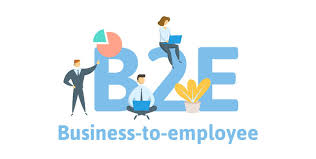
In today’s hyper-accelerated corporate environment, the job market is becoming increasingly open, fluid, and competitive.
This is the result of substantial change at the political, social, and economic levels, and it’s a trend exacerbated by digital transformation’s technology breakthroughs, which have impacted all sectors.
When faced with change, we cannot just freeze or bury our heads in the sand: the most innovative businesses understand this and look for fresh opportunities behind every difficulty and transformation.
While marketers and operators across the board recognize the importance of customer experience in solving engagement and loyalty difficulties, they may have overlooked one “experience” factor that is even closer to home: appreciated workers.
Employee experience is about more than just acquiring talent; it’s about keeping your most competent and talented people happy and at the center of your attention, and making them into the true brand and corporate ambassadors. B2E (Business to Employee) accomplishes this.
What is B2E?
B2E (Business to Employee) is a technique that focuses on employees, similar to B2B (Business to Business) and B2C (Business to Consumer).
It encompasses all operations aimed at achieving the highest possible retention rate. This comprises, among other things, recruiting and onboarding, team-building techniques, training courses, scheduling flexibility, bonuses and special offers, and a variety of benefits.
It’s crucial to note, however, that the term B2E is frequently used to refer to platforms for Business to Employee communication and sharing, such as the company intranet. For example, the most dynamic organizations (which are frequently also the healthiest) are frequently equipped with the customized home page or desktop solutions.
As a result, a basic subject, that of personalization, is beginning to emerge, and we shall focus on it a little later.
B2E systems are frequently used interchangeably with business intranets. However, this is not the case: the intranet’s concentration is on the corporation, whereas B2E portals’ focus is on the individual. This is a significant distinction.
On the one hand, an effective and well-designed Business to Employee system must include everything an employee would expect from a traditional intranet, and on the other hand — and this is the most important and innovative part — it must incorporate personal information, personalization opportunities, and tailor-made communications that are as dynamic, interactive, and omnichannel as possible.
The goal of a B2E digital environment developed in this way is to improve not only productivity but also employee satisfaction, which, in turn, improves the sense of community and sharing of the company’s values almost spontaneously. In a constant, easy, and fruitful interaction, the employee can no longer be thought of as one of many, but as an active agent who can dramatically impact the future of his firm.
In this direction, there is still a long way to go. Consider how, in this area, most organizations now rely on a combination of external apps, such as Slack, Google Calendar and Google Drive, Dropbox, and Skype (to name a few). While such systems are important, they are not tailored to specific businesses, and customizing options are restricted.
It’s no surprise, however, that according to a recent Gartner survey, 40% of such investments fail to deliver the expected return on investment (Return on Investment). It’s all about having a good time.
Take, for example, Deloitte’s 2017 Global Human Capital Trends Survey, which polled over 10,000 company leaders and HR managers from over 100 countries. Approximately 80% of respondents rated employee experience (at all levels) in the workplace as “important” or “extremely important” in this study. In this area, only 22% of respondents evaluated their firm as “great.”
This type of analysis is more useful than theories in explaining why practically every company is putting more emphasis on B2E systems and platforms. The void to be filled is enormous.
“…user experience is arguably even more strategically important inside the enterprise than out,” wrote Elizabeth Rosenzweig, an expert in information systems architecture and a consultant on User Experience issues at Bentley University in Massachusetts and author of “Successful User Experience: Strategies and Roadmap.” “Consider the digital tools that individuals in your company use every day to track time and expenses, check email, coordinate travel, and perform hundreds of other everyday chores,” she says. These employees are trapped, forced to utilize your company’s software systems regardless of UX quality, and relegated to calling for help if they don’t comprehend it. What percentage of their time do these systems waste? And how much does it cost you in terms of call center costs, potential churn, and lost commitment?”
Unfortunately, Rosenzweig’s experience is all too typical, and it harms staff retention. Excessive turnover can be costly (think of the costs incurred for finding and then training a new employee). The damage can then be seen in your company’s reputation, which can be exacerbated by sites like GlassDoor, which allows current and former employees to anonymously criticize organizations.
In short, we’re becoming more aware of the importance of B2E, and the path forward is very clear: personalization.
Personalization: The Final Turning Point
The finest B2E plans integrate best practices and tried-and-true marketing, customer service, and HR procedures. It’s a matter of relearning how to communicate in a simple, user-friendly, interactive, and multi-channel manner, using messages that are as tailored as feasible.
Every employee is unique, and they expect to be treated as such. Thanks to the most advanced technology for gathering and organizing data (especially “smart data” or “deep data”), customization may now be successfully applied to big groups of people.
Personalized mini-websites can be built on this foundation, and tailored messages can be communicated in a one-to-one interaction.
The concept was to use video as the most effective mode of communication. A customized video was delivered to each employee, outlining the company’s benefit options in three sections. Individual employees were able to quickly and easily learn about employee benefits with only a few clicks using this platform.
